► A Mazda CX-5 in deepest Siberia
► Across world’s largest fresh-water lake
► Did the family SUV survive its ordeal?
When was the last time your life depended on your car? I mean truly depended on it? It’s not something that’s occurred to me before, but it’s front of mind now. We’re in a remote forest in Siberia, night is closing in fast, the temperature plummets below -10 degrees. And we’re stuck.
As a consequence of my momentary lapse of concentration, photographer Tom Salt and I are now embedded in a snow bank and going nowhere. We’d been laughing about bears and wolves moments before, but now we’re thinking ‘what if’…
It’s an unlikely and unexpected diversion in one challenging driving adventure. This one had looked simple in the planning stages: fly into Irkutsk, pick up a car, and drive it a few hundred miles to Ulan Ude via the lakeside resort of Listvyanka.
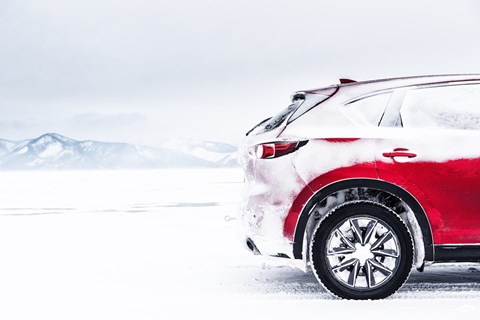
We’d take the Trans-Siberian Highway, which is part of the world’s longest road. There, we’d be battling with the ceaseless flow of HGVs thundering from China to Europe, delivering an unending supply of consumer goods to feed the unending demands of European consumers.
Feeling like a million miles from home
To cut out a five-hour detour around the south of Lake Baikal, we’d be driving across it. Luckily for us, between December and April, it becomes a perilous but navigable land bridge that joins one end of Siberia to the other. What could possibly go wrong?
As we sit in in our car that’s already been warmed up for us, idling quietly away outside Irkutsk airport, we already feel a long way from home. Although this looks to all intents and purposes like European Russia, we’re deep into Asia.
A couple of hundred miles to the south of us lies Mongolia, and south of that is China. To the north is tundra. Lots and lots of tundra. We’re just one time zone away from Tokyo, and such is Russia’s ability to scramble your sense of distance and scale, it’s an uncomfortable three-day railway ride back to Moscow.
Hitting the road, Siberian style
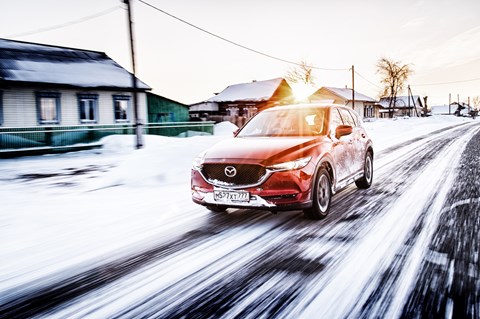
Everyone’s in big coats and fur hats, and the looks being cast towards us – as obvious foreigners – are as cold as the chill wind howling in from the East. At least the car awaiting our arrival is familiar. It’s a Mazda CX-5 in Russian market-spec 2.5-litre SkyActive petrol form, and hardly the sort of thing you’d associate with adventuring.
Marketeers will tell you that these family-oriented SUVs are built exactly for this kind of outdoorsy frontier work, but we’re not so sure. Those 19-inch alloys look dainty, and we know that in Russia, the roads don’t so much have potholes, as chasms.
The cars around us are a fascinating mix of Soviet-era retro, right-hand drive Japanese-market imports from the mid-1990s to mid-2000s, and a splash of flash new premium European metal. Horns bleat insistently, engines rev, and there’s a gladiatorial mood in the air. And we’ve not even set off yet.
Check out all our Mazda reviews
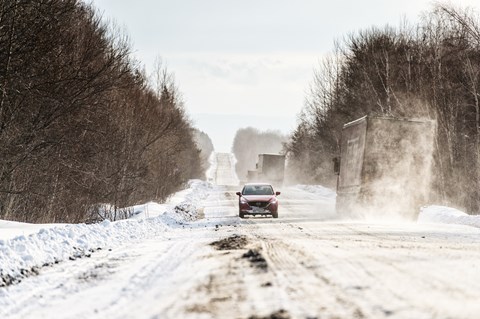
Mazda CX-5: unmodified for task ahead
We’re already well acquainted with the CX-5, and considering what we have lined up for it, the lack of modifications – aside from a set of studded winter tyres – seems brave. Optimistically, you’d say that this is Mazda’s vote of confidence in the car’s abilities, and we’re not too concerned at this point.
It may be a wagon that typifies the school run, and a good example of a generation of C-segment SUVs that’s rapidly replacing the hatchback as the global family car of choice. But there’s decent ground clearance, and hunky cladding on its flanks. It’s a stylish example of a multi-purpose breed of car that’s taking over the world.
Ugly and discoloured ice and snow mounds are piled up everywhere, and the roads around the airport are rutted rivers of compacted ice. Aside from plentiful and gaudy roadside advertising hoardings, and our lipstick-red Mazda, there’s a depressing lack of colour. It’s a picture-perfect rendition of what we’d imagined a Siberian city in the winter would look like.
Hitting the road, Siberian style
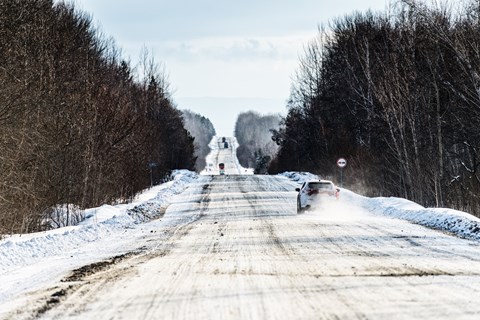
It’s soon clear that the Russians are good at keeping their roads well salted, and everyone appears to be on winter tyres. They’re behaving pretty well, and thanks to four-wheel drive, our Mazda isn’t struggling for grip either. Confidence and a feeling of ease soon follow. Conditions that would have the UK grinding to a halt are laughed off. It can’t be this easy, surely?
As the city thins out, and dense pine tree forest replaces houses and shops at the roadside, we get more chance to see how the electronically-controlled four-wheel drive system works.
Our A-road opens up to a series of long straights stretching off into the horizon. A few gentle bends punctuate this perfect symmetry, but as the surface is mainly compacted snow with ruts carved into it, there’s plenty of opportunity to feel the torque-sensing transmission dole out grip to the front and rear of the car on demand.
Simple challenges – interesting consequences
Overtaking slower cars throws up other challenges. Leaving the sanctuary of your ruts to cross into the path of oncoming traffic has the CX-5 squirming gently in protest. But it never loses grip, and once we’re dialled into this additional body movement, loosening a grip on the wheel and allowing the car to roll with surface changes feels the most natural thing in the world to do.
Loping along at the 90km/h (56mph) limit in these conditions feels natural but about as fast as we’d want to go. We think we’re doing quite well until a flamboyantly-driven Soviet-era UAZ van comes steaming past us, nearly taking us out as he cuts us up sharply to avoid an oncoming Lada he’d seen at the last moment.
I sense Tom pucker up, and I laugh nervously. That’s a wake-up call. We’d clearly been getting a bit too relaxed about the Trans-Siberian highway.
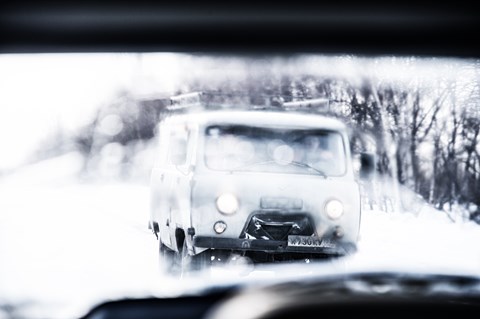
On to Lake Baikal
There would be more moments like this on way to Listvyanka. We get there in one piece, nerves not quite shredded, but we’re a fair way from being relaxed. And that’s probably about right, as we’re beginning to understand that you should never take anything for granted in Siberia.
To describe Listvyanka as a resort is overstating things, really. It’s basically a collection of Siberian-spec wooden houses, shoddily-built Brutalist hotels, and tacky gift shops.
It’s a grey day and there’s been a fresh snow fall, which leaves the back streets looking so sparkling that even the mouldering and abandoned cars and boats have a strangely virginal quality. The ships in the harbour are frozen in for winter, and there’s little sign of activity.
Lake Baikal: outstandingly beautiful
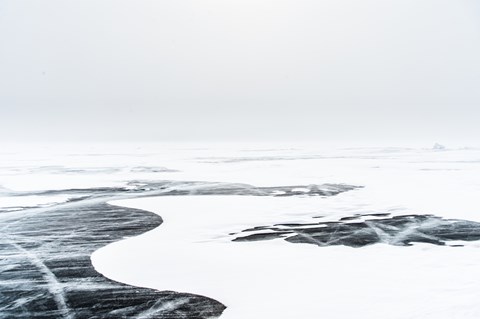
But it’s the view over the lake that really gets our attention – it’s pure white and frozen solid. It’s impossible to see where the ice ends and the sky begins. Of the horizon, or the mountains on the other side, there is no sign. It’s a white-out, and we’re going to drive across it in the morning. It’s then that the significance of our drive across the lake begins to sink in.
Then Tom and I spot a UAZ van joyously driving across the ice before disappearing into the distance. It’s a reminder that conditions we consider exceptional are ordinary for Siberians. Given those vans are high-riding off-roaders and nigh-on unstoppable, I smile a little for the driver. I bet he’s having fun out there.
Before taking to the ice the following morning, we need briefing, and we’re going to get expert guidance from the National Russian Safety Team, Emercom, to get us safely across. Mazda’s taking no chances with this one, and has ensured that we’re in safe hands. Alex Simakin and his team will lead the convoy in a 6×6 Trekol 39294 buggy (below) to safely navigate across the lake surface – fissures, ice banks and snow drifts and all.
The adventure gets real
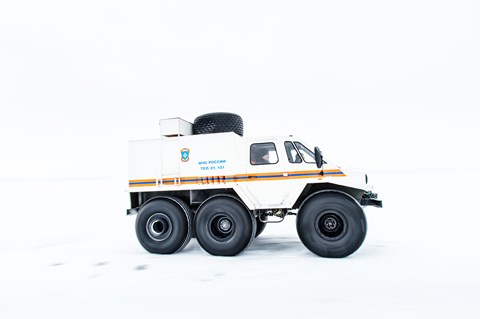
In the typically unimpressed way that Russians deliver big messages, he says that at least one person a year dies making similar crossings. Because of the sheer vastness of Lake Baikal, the ice sheets move like great continental plates that crash into each other, tear apart, and create huge ice shards that are more than capable of killing your car – and you. If you fall through the ice you’re unlikely to be found – at its deepest point on our crossing Lake Baikal is more than a kilometre deep.
On paper, the idea of driving across a frozen lake hadn’t seemed that challenging. We’ve seen a million ice drives before, and ice usually looks calm and flat. This one’s going to be different. Suddenly, it’s getting real.
We join a convoy of 15 other CX-5s from around the world, and file in behind the Trekol, and drive onto the lake’s surface. This is now feeling both weird and not a little worrying. Yes, we’re in good hands, but the idea of driving on top of water sparks irrational fears. But they subside very quickly as you begin to normalise to the situation.
Driving on a lake of ice: what it’s really like
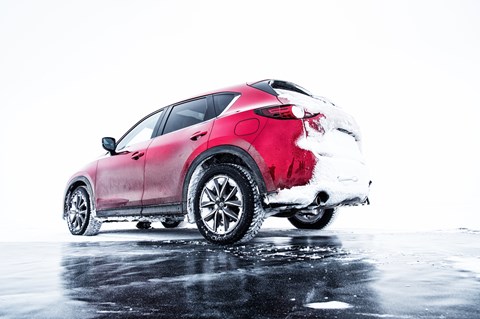
The crossing we originally had planned was about 20-miles long, but due to the rapidly changing conditions, Emercom had altered the route to take us to a village further north on the other side of the lake. The total crossing distance would now be a little more than 40 miles, and according to Emercom, our trip would be the first time road cars had ever made the crossing. Really, nothing to worry about.
Initially, Alex’s Trekol roars off into the distance, seemingly floating over the worst of the surface. Within moments, he’s disappeared in a cloud of kicked-up snow, and we’re calling for him to slow down on the radio, while getting used to the drifting snow. Following the instruction to punch through each bank quickly and ‘precisely’ is a pretty effective tactic.
Within moments, he’s backed off to a manageable pace, and the convoy regroups behind as we pick our way carefully through. The further we move away from the coast, the tougher the going gets. Each snow bank conceals man-sized shards of ice, and in avoiding these, cars around us get stuck and need digging out by the Emercom team. Mile after mile, we grind on – the wind howling, and the scenery shifting around us.
Baikal challenge: keep it out of the snowdrifts
Alex eventually slows down to accommodate our pace. But the anticipated four-hour crossing is shredded by the wind and conditions. Three hours in, and we’re not even half-way across. We’ve adapted to the conditions, though, and marvel at the Mazda’s four-wheel drive system, which does a great job of keeping us moving, digging out traction where there’s literally zero grip. If the car starts to understeer, I plant the throttle and let the electronics sort things out – that’s the modern way.
The best method of driving in these conditons is simple: look as far ahead as possible, stay in the tracks made by vehicles ahead, and let the snow steer you round. In affect you merely guide the car, while keeping fresh snow in view in order to brake on.
It’s simple in theory, but extremely taxing in practice. I welcome the stops as drivers in the convoy get stuck. Jumping out and standing on the ice, looking down and drinking in its purity, is a near-spiritual experience. As is the silence and utter feeling of remoteness. Getting back in the car and carrying on is almost a relief.
Digging for Siberia
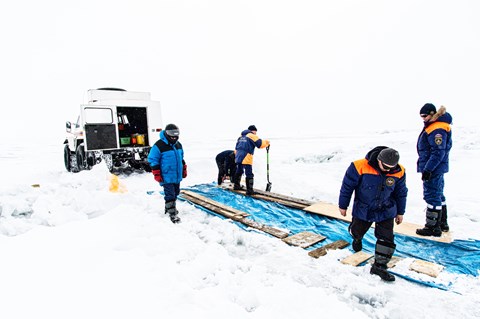
Once more the convoy comes to a graceful halt. This time it’s a longer stop. The lead vehicle has encountered a tear in the ice, and there’s no way to cross safely. But the Emercom team comes fully prepared and has already warned us that they’d be building a bridge to get us safely across. I use the opportunity to jump out, this time being struck by the complete lack of visual markers – no horizon, no colour, just white as fas as the eye can see.
Imagine my surprise when that ‘bridge’ assembled by the team is a few planks of wood and a tarpaulin. Given the water is a kilometre deep at this point, I expect something more elaborate. Still, in for a penny…
Once assembled, the Trekol crosses, which is followed by Emercom’s lead car. Then it’s our turn – and again the instruction is simple. ‘Not too fast. Not too slow. And precise,’ Alex’s voice crackles over the radio. I don’t overthink it. Look into the middle distance, point in the right direction – the car shifts uncomfortably on the wooden planks as we advance, and we’re thrown in our seats as we get to the end. We’re over. Phew.
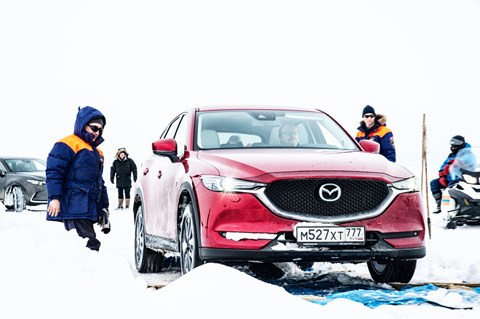
And on to the home straight
Nerve-wracking ‘river’ crossing complete, we’re on our way again, and the slow progress to the other side of the lake continues. We’re six-and-a-half hours in before the coast slowly fades into view through the whiteness. And never more relieved – and elated – have I felt.
By the time we ride up the bank and back on to terra firma, I’m ready for a drink, a sleep, and to calmly lie down. Except there’s the small matter of the infinite ribbon of tarmac, gravel and mud, known as the Trans-Siberian Highway, and the drive on to to Ulan Ude.
Tom and I break away from the Mazda convoy and do our own thing. We want to go exploring, and get some shots of the Trans-Siberian Railway while taking in the local sights and sounds. The first village we encounter on the road, and we’re turning off to see what’s what. And straight into more improbably-deep snow that’s drifted up to the rooflines of the smaller cottages.
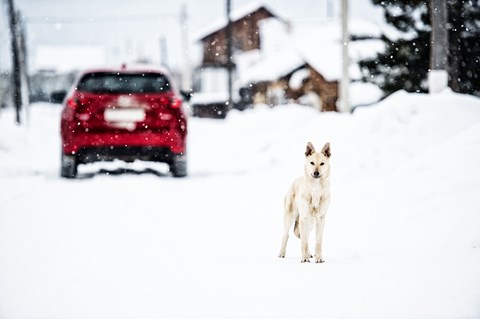
A diversion into the forest
They are achingly beautiful villages, but life must be hard here, especially at this time of year. We stop, and take in each one, drinking in the atmosphere, and marvelling at the natural beauty of the place.
In contrast, the road is dangerous, rutted and strewn with accident damage. Its constant companion is the Trans-Siberian railway, upon which freight and passenger trains ceaselessly rattle along it.
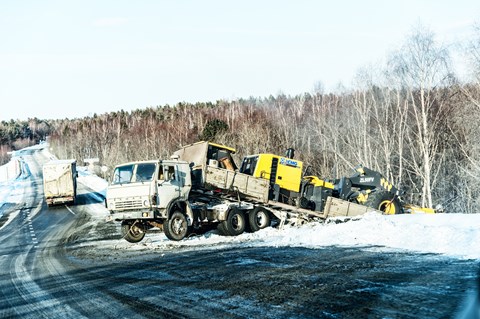
We need to be in Ulan Ude, but instead, turn into a forest to experience the feeling of genuine remoteness. As we run deeper into the dark forest, Tom keeps asking me to stop to get pictures.
More than once he jumps out of the car, and immediately ends up waist deep in the snow. About five miles in, we turn around and head for the ‘safety’ of the road. And it’s towards the end of this run, and with the woods rapidly darkening, that we find ourselves bogged down, trapped in a ditch unable to reverse the car out.
Until then, the CX-5 had been more than up to the task in hand, punching through the deep stuff and powering through the bends extremely effectively.
Never, ever drop your guard
But I’d become blasé: ‘follow the tracks, keep your foot in, and drive quickly and precisely,’ Alex had told me, and it had worked well so far.
What hasn’t sunk in is that you shouldn’t drop your guard. Even for one second. I allow the CX-5 to drift a couple of centimetres too far the right, and before I know it, the snow bank pulls us in, and down into a ditch that welcomes us with an icy embrace.
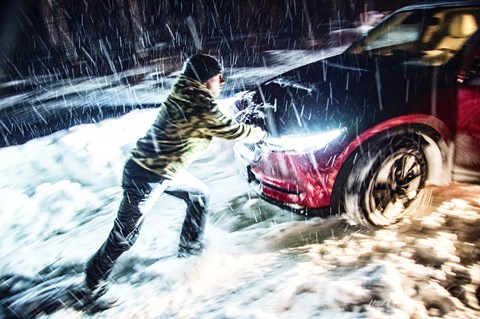
The loss of directional impetus unfolds slowly – laughably so – but no amount of steering or throttle counteracts the sickening and magnetic pull into our doom. With the car at rest, engine idling, I look across at Tom and say, ‘bollocks’…
It’s at this moment that those thoughts of my own mortality, no doubt egged on by Tom’s super-descriptive descriptions of what a giant bear, ably assisted by a howling pack of wolves, could do to our CX-5, kick in. Before we’re galvanised into action, a pair of headlights appears behind us, and I jump out to stop the driver.
As he can’t pass us anyway, he hops out to greet me, bellowing in Russian. I have no idea what he’s saying, and simply gesture at my stricken Mazda in the hope that he understands my insane gesturing. Whether he does or doesn’t isn’t clear, but he quickly turns back to his Dacia Duster and grabs a towrope.
Tow-job to Siberian freedom
After a long, cold struggle where Tom finds himself – yet again – waist deep in snow, our Dacia-driving white Knight wrenches the CX-5 clear of the ditch. I feel like hugging the man, but he just want to get on his way, and I’m blocking his path. Besides, we need to get back to the road. And on to Ulan Ude.
The rest of the journey is uneventful, and I’m not exactly sad about that. I’m now convinced that the CX-5 really is the best car in the world – right now – because my life depends upon it. Later, as I relax in the relative luxury of our Ulan Ude hotel, I smile at the plucky little car, which basically took everything we threw at it in its stride and came out of the other end smiling. Not bad for something you’d normally associate with the school run.
The drive through Siberia and across Lake Baikal certainly gives perspective. It’s an opportunity to consider the dangers, excitement and beauty of this remote part of Russia. It’s an inspirational place – unimaginably empty, vast and open – and one that proves that your car really can be the difference between life and death.
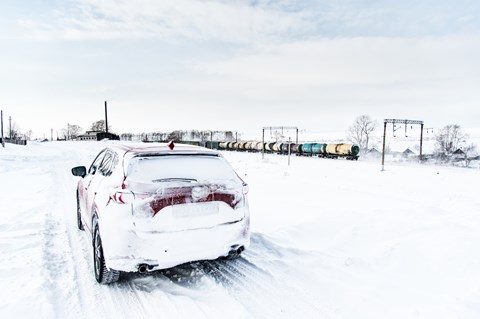
Photography: Tom Salt